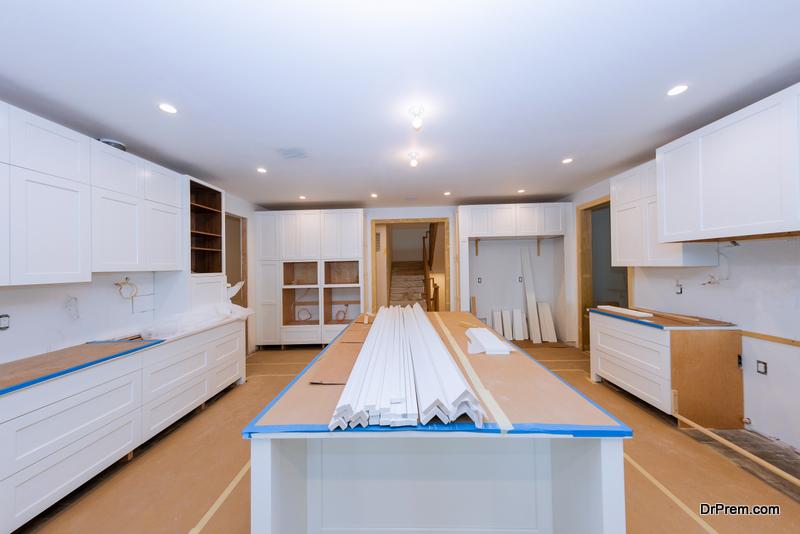Are you looking to remodel your kitchen and spice up your cooking game? Universal Design is the secret ingredient that will take your kitchen from bland to grand!
Whether you are a professional chef, a foodie, or someone who loves to whip up a good meal, the universal design philosophy is all about creating a kitchen that is accessible and enjoyable for everyone.
No more struggling with awkwardly placed cabinets or hard-to-reach appliances! With the help of a comprehensive design that just works, you can now create a kitchen that is functional, beautiful, and personalized for your taste.
Grab your apron and prepare to cook like a pro in a kitchen designed for your convenience.
1.Create Contrast
According to a Universal Design Certified Professional (UDCP), contrast helps build the perception of spatial boundaries. There should be a contrast between the flooring and cabinets as well as between the cabinets and the countertops, so that those who have low vision may see the transition from the floor to the cabinets. For example, white oak hardwood flooring and walnut cabinetry provide enough contrast without resorting to black and white.
2.Consider Your Exteriors
When it comes to creating an accessible kitchen, every little detail from your interiors to your exteriors counts. This is where vinyl siding comes in.
Vinyl siding is a great addition to any universal design kitchen remodel. Installing vinyl siding on the exterior of your house can be a game changer especially if you are planning to design an outdoor kitchen.
Vinyl is a durable material that is easy to clean and maintain, making it a smart investment for your outdoor cooking area. With vinyl siding, you can truly enhance the accessibility and beauty of your universal design house.
Whether you are based in Northampton or Suffolk county, contact your nearest siding contractors to get your vinyl siding installed!
3.Layer Light
If you have access to natural light, use it. To make food preparation and cooking safe, you will need task lighting above your work stationlike the island and hob. According to Certified Living in Place Professional (CLIPP), it is recommended to use dimmable lighting for overhead lights and under-cabinet lighting on prep surfaces.
Lighting the interior of drawers and illuminating the base of cabinets to highlight the room’s layout and depth are new and effective universal design lighting trends.
4.Choose Simple Countertops
The countertops in any kitchen are constantly in use, which is why they should be easy to operate and pleasant to look at. A good tip is to use light, neutral colors and basic patterns since they improve visibility. In addition to that, a matte finish is perfect for those with vision impairments due to its lower reflective qualities. You can also go for low-maintenance materials for your countertops, like porcelain and quartz because of their resilience and easy to clean feature.
5.Pull Out Storage
Storage options like garbage pull-outs, roll-out shelves, swing-up mixer shelves, and pull-down shelves offer increased flexibility. These pull-outs are not only accessible to specially- abled people, but they also make it simple to see what you have stashed away in your cabinets.
Adding more drawers to the kitchen cabinets would have the same effect. Instead of storing your dishware and glasses in the upper cabinets, where they are less accessible, they can be stored in drawers with storage inserts below the countertop.
6.Open Shelving
According to a designer at Builder Supply Source LLC, Associate Kitchen Bath Designer (AKBD) and Certified Living in Place Professional (CLIPP), open shelving not only makes it easy to see the products you’re looking for but also makes those items easier to access. In comparison to closed base cabinets, open shelving eliminates the need for clearance when opening doors, making it more accessible for people with limited mobility.
- Choose Single-Lever Faucet
Choosing a single-lever tap makes it easy to control the water flow, especially for people with disabilities. People with arthritis will find single-lever devices especially helpful because they can be operated with both, an open hand or a closed fist. Touchless and voice-activated faucets are becoming especially popular in modern kitchens and are fantastic examples of universal design. Any faucet’s lever should indicate which way to turn it for hot or cold water.
8.Install Cabinet Hardware
It’s tough to open or close cabinets and drawers with complex hardware, especially for people with disabilities. However, compared to regular knobs, D-shaped door and drawer pulls are more convenient for those with arthritis or other mobility limitations. It becomes easier for everyone to operate and use the hardware because there’s plenty of room between it and the cabinet. This is why a lot of people prefer these modifications rather than cabinet handles that are carved in.
It is recommended that you use D-shaped pulls to keep potentially dangerous items, like knives or scissors, locked away and out of the reach of youngsters and those with cognitive disabilities.
9.Landing Spaces
Landing spaces are countertops that are usually adjacent to your kitchen workspace. They are known to increase safety in the kitchen, such as when you’re retrieving hot food from the microwave or heavy pots off the hob, by providing a safe drop zone. Drop zones also eliminate the need to transport items through a crowded area until it is more convenient.
In traditional-style homes, appliances were usually placed wherever an electrical outlet, gas line, or water supply was available—sometimes inconveniently far from the main kitchen area and countertops. This is where the addition of a landing space comes in. You may especially want to consider it if you cook at home often.
10. Eliminate Flooring Hazards
When selecting the right flooring for your kitchen, it is important to consider that your kitchen is the busiest area of your house..This is why you should avoid rugs and other trip hazards, like transition pieces, between types of flooring. It is safer for everyone, especially those using mobility aids, if the ground is flat and unpolished.
Moreover, if you keep the grout lines to a minimum, you can go for a material like tile for your kitchen flooring. It is best to install porcelain tiles because of its great slide resistance. Nevertheless, the tiles must be flush to prevent any trip hazards that are often caused by protruding tiles.
While a kitchen rug can add color, protection, and comfort, it can easily become a tripping hazard and should be avoided.
11. Vary Countertop Heights
Counters that are placed at various heights in the kitchen are more accessible to people of varying physical abilities. A countertop that is approximately 30 inches high would be equivalent to the height of a dining table, so children, individuals with limited mobility, and average sized adults can all use the space comfortably, whether as a workstation or for cooking and dining. As a general rule, your island and countertops should be between 28 and 30 inches, while your cooking area should range between 34 and 36 inches.
12. Make Room for Appliances
When designing your kitchen, it is important to think about where your appliances will go. To increase accessibility, it’s best to leave appliances out in the open rather than cram them into tight spaces, like corners or against a wall. Make sure there’s space on either side of an appliance so that those with limited mobility can access the appliance without needing to be in front of it.
For instance, your dishwashing rack will be easier to reach from the side, especially for pregnant women or those using walkers.
13. Replacing the Range
Ovens built into the wall can be positioned by the universal design guidelines or according to your preferences. A standalone wall oven eliminates the need to bend down to put in or remove items from the oven, as it can be installed at a height that is convenient to you.
If you live with someone who has mobility issues, choose a stove top that is easier for them to access. For example, choose front-mounted controls with obvious labels indicating the burners they operate. In this way, they are more visible and provide less risk of injury.
14. Change to Induction
Think about upgrading to an induction hob or hob instead of using gas or electric induction. When it comes to ease of use, induction hob cooktops are the most user-friendly for everyone. The hob can be turned on, but no heat will radiate from the surface until a pot or pan is placed on it. This is ideal for households with young children or seniors.
15. Kitchen Rack Next to the Fridge
Choose a side-by-side fridge so people of varying staturesand mobility levels can easily access its storage compartments. Another option is a built-in refrigerator and freezer drawers. A built-in refrigerator and freezer can be stacked or placed below your counters for easier access. They are also convenient for inspecting the contents in your fridge because they can be removed.
16. Clearance for Mobility Devices
A kitchen’s storage and prep space can be significantly improved by installing an island, peninsula, or breakfast bar. However, they can also clutter your kitchen design, making it hard for you to move around freely. The National Kitchen and Bath Association suggests a working aisle between 42 and 48 inches wide (or perhaps more, depending on the design of the kitchen). It is recommended that you leave out at least 60 inches of free space behind your kitchen table so that it is easier for people to move around it.
17. Recess Areas for Seated Users
If you want to make your kitchen accessible to people who use wheelchairs, install recesses in the lower cabinets, especially near the stove, sink and food preparation areas. It is also simpler for you to access the bottom cupboards from your chair. You can even use wheel cabinet components that can swing out to create a recess area to prevent sacrificing storage space. These portable cabinetry choices provide storage, versatility, and aesthetic appeal.
18. Kitchen with Built-In Microwave
A built-in microwave can be placed anywhere – underneath a washbasin or counter – making it more convenient for everyone. It also helps you avoid the risk of injury from reaching into an over-the-range microwave when removing hot items. You should consider whether the microwave has a drawer door, a drop-down door, or a conventional swinging door, as well as where the control panel is positioned.
19. Find the Right Dishwasher
Many people have difficulty loading and unloading the dishwasher because of the need to bend and reach. This is especially true for someone who uses wheelchairs or has shoulder issues. Besides, the dishwasher will be easier to load if you raise it. You can also go for dishwasher drawers as they are more compact and can be moved and installed conveniently.
A good tip is to place the dishwasher on a stand a few inches from the floor. However, if you have an elevated dishwasher, you may also need to raise a section of your countertop, which might affect accessibility in other ways, especially if your dishwasher is near your sink. This is why it is better to go for an elevated dishwasher.
To Sum Up
Universal design is not just a buzzword – it’s a game changer! By incorporating the principles of universal design into your kitchen remodel, you can create a space that is not only beautiful but also accessible and functional for everyone. From vinyl sliding doors to pull-out shelves and beyond, there are endless design options available to make your kitchen a space that works for you.
Let Universal Design help you create a kitchen you’ll truly love . After all, the heart of the home deserves nothing less!
Article Submitted By Community Writer




